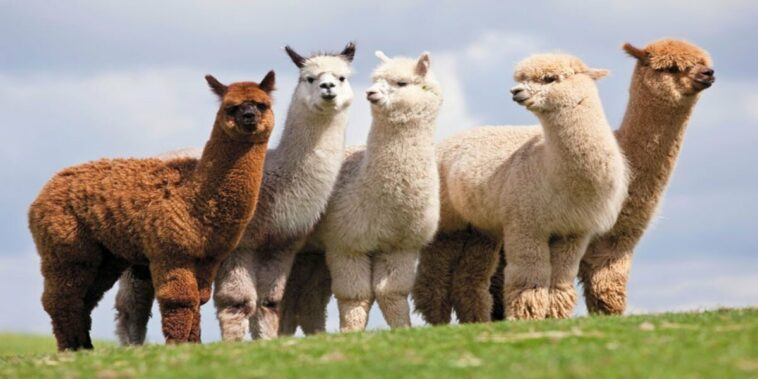Table of Contents
The alpaca, a member of the order Artiodactyla and the family Camelidae, is distinctive for being the most numerous and smallest South American camelid species.
The alpaca, information, characteristics and more
Similar to the llama and the guanaco in external appearance, it differs in weight and size since an adult specimen measures between 81 and 99 centimeters in height and weighs between 48 and 84 kilograms.
It has large, pointed ears. The body is slender and has a long narrow neck; of course, this slender neck is noticeable when it is not covered with wool, as it grows up to 50 centimeters and has a variety of white, brown and black colorations. The coat can be of a uniform color or multicolored.
Its canine teeth are positioned on both jaws and measure about 3 centimeters in length. The female does not have as well developed canines as the male, but with the exception of this characteristic, both sexes are physically similar.
Distribution and habitat of the alpaca
The alpaca has a reduced distribution; it is present in the Andean regions of South America at an altitude of 5,000 meters above sea level. It lives in Peru, Bolivia, Chile, Ecuador and Argentina but is now also present in countries such as the United States, the Netherlands, Australia and New Zealand as a result of its introduction in the 1980s. Despite this, 99 percent of alpacas live in South America.
They inhabit the mountains, savannahs and grasslands of the Andean Altiplano, near humid areas and with temperatures below 0 degrees Celsius at night.
The alpaca is a domesticated species.
Behavior of the alpaca
The alpaca is a social animal and lives in family groups. Some researchers maintain that the groups are hierarchically organized: they are composed of an alpha male, female and male alpacas and their offspring. Alpacas are capable of warning their fellows of danger by producing a kind of squawking sound. They also usually defend themselves by spitting or kicking intruders.
Food of the alpaca
It is an exclusively herbivorous animal and its diet is composed of grass, hay, stems, bark, tree leaves and grass species such as Festuca nardifolia, Agrostis Tolucensis and Deschampsia Caespitosa. When eating, the alpaca chews the food in 8 movements. It then swallows it and passes through 3 chambers to continue the digestion process.
It needs too much food to satisfy its body’s requirements. Alpaca breeders usually supplement the animals’ diet daily with a dose of cereals that provide important vitamins for growth.
Reproduction of the alpaca
The alpaca is a polygamous species and some breeders claim that it forms harems composed of 5-10 females. The female reaches sexual maturity between 12 and 24 months of age, and the male can reproduce from the first year of age, although some are sexually mature up to 3 years of age.
It is capable of breeding throughout the year. In mating, the male positions himself over the female and the female allows the male to introduce the sperm while emitting a vocalization known as “orgling”. Twenty-four hours later, the female begins to ovulate and birth occurs after a gestation period that lasts between 242 and 345 days. Normally only one calf is born, weighing 8 to 9 kilograms, and is weaned between 6 and 8 months of age.
An alpaca can live up to 20 years.
- Facebook Messenger

